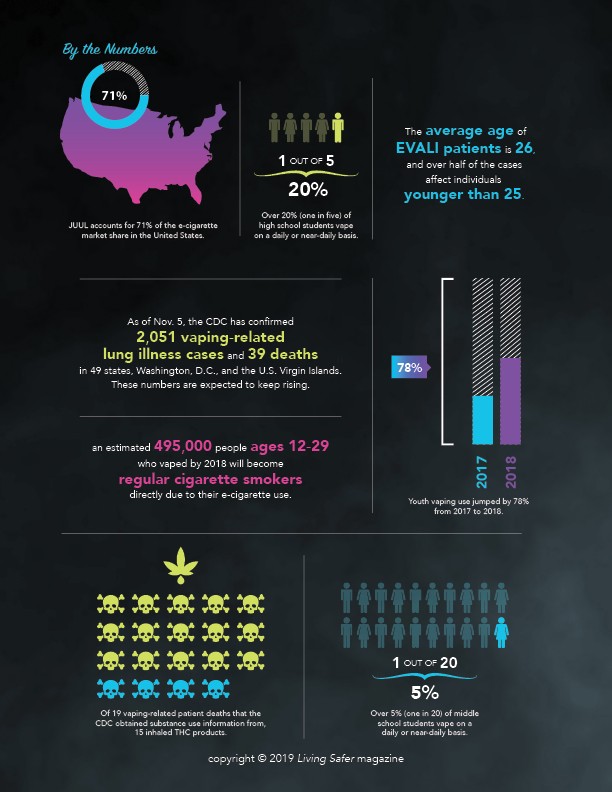by: Rachel Gore
Recently, vaping addiction and its accompanying lung illness outbreak have been at the top of national news. U.S. health officials are scrambling to identify what is causing thousands of vapers to develop the potentially fatal lung disease “EVALI” as new cases are reported each day. Even more alarmingly, teens and young adults are being disproportionately impacted by the epidemic, making it every parent’s worst nightmare.
While there are several vaping products on the market, one company in particular—JUUL Labs, Inc.—has played a particularly powerful role in fueling the epidemic in teens. In addition to being by far the most popular e-cigarette distributor on the market, there is evidence that the company allegedly hooked adolescents—intentionally—on vaping and illegally marketed JUUL® products as a safe alternative to cigarettes. Here’s everything you need to know about vaping, the public health crisis and JUUL’s alleged role in causing it.
The History Behind JUUL
Before JUUL, there was Ploom®. Ploom was a San Francisco-based company founded by Stanford University Design Program graduates James Monsees and Adam Bowen, who came up with the idea for Ploom together as students. Ploom originated in 2007 and raised nearly $1 million in venture funding by February 2008 for its e-cigarettes, the first in a line of products that would eventually become JUUL. Ploom devices are heatable vaporizers filled with single-serve Ploom Pods containing tobacco or non-tobacco ingredients. Ploom Pods were the precursor to the JUULPODS™ currently ravaging the nation’s youth.
In 2013, Ploom launched a loose-leaf tobacco and cannabis vaporizer called Pax®. While the original Pax vaporizer has since been discontinued, second- and third-generation Pax devices are still available for purchase and remain popular among cannabis vapers today. In February 2015, two years after the original Pax was released, Monsees and Bowen sold the Ploom brand to Japanese tobacco company JTI, which rebranded itself as Pax Labs, Inc. On June 1, 2015, Pax Labs introduced JUUL to the world with a youth-oriented campaign and accompanying New York City launch party. The JUUL is a small nicotine-based e-cigarette that resembles a USB flash drive and uses single-use cartridges known as JUULPODS. Guests of the launch party were invited to test free samples of JUUL products and share selfies of themselves at the party on social media.
JUUL Labs, Inc. spun off from Pax as a separate company in July 2017. The rest is history, with JUUL taking its spot as the most popular e-cigarette on the U.S. market by the end of the year. JUUL sales skyrocketed 621% year-to-year, generating over $224 million in retail sales by November 2017. Today, JUUL’s presence as the most popular vaping brand has become so apparent that some vapers use the terms “vaping” and Juuling” interchangeably.
What’s the difference?
The main difference between vaping and smoking revolves around what is being inhaled. While cigarette smokers inhale the smoke that is produced by burning tobacco, the term “vaping” describes smoke-free products that produce an inhalable vapor. E-cigarettes, or vapes, involve the heating of a liquid, and the vapor it releases is considered smokeless.
While there was a widespread misconception that vaping is a healthy alternative to cigarette smoking, in part due to alleged deceptive marketing tactics used by companies like JUUL, the recent outbreak of vaping-related lung disease has made many realize that this is not true.
JUUL’s alleged Illegal Marketing Tactics and Deceptive Packaging
Recent developments regarding vaping-related public health concerns have revealed that JUUL may have intentionally targeted children and teens to be consumers of its products. In fact, the U.S. Food and Drug Administration (FDA) issued a warning letter to JUUL on Sep. 9, 2019 for making illegal claims about the safety of its e-cigarettes. The letter came after the FDA reviewed testimony from a congressional hearing on “Examining JUUL’s Role in the Youth Nicotine Epidemic,” which took place on July 24-25, 2019 in the U.S. House of Representatives. During the hearing, two New York teens testified that a JUUL representative had made several misleading claims in a presentation at their high school, including that the “FDA would approve [JUUL] any day” and that students “… should mention JUUL to [their] [nicotine-addicted] friend[s]… because that’s a safer alternative than smoking cigarettes and would be better for the kid[s] to use.”
In the letter, the FDA tells JUUL that referring to its e-cigarettes as “‘99% safer’ than cigarettes, ‘much safer’ than cigarettes, ‘totally safe,’ and a ‘safer alternative than smoking cigarettes’ is particularly concerning because these statements were made directly to children in school.” The letter also mentions that JUUL’s “Letter from the CEO,” which is on its website and has appeared in emails sent to parents, makes the claim that “[JUUL’s] simple and convenient system incorporates temperature regulation to heat nicotine liquid and deliver smokers the satisfaction they want without the combustion and the harm associated with it.”
To legally make public claims about the safety of a product, companies need to be granted an appropriate FDA order verifying the claims are true. It is illegal to do so if an order hasn’t been granted, according to Acting FDA Commissioner Ned Sharpless, who said that “regardless of where products like e-cigarettes fall on the continuum of tobacco product risk, the law is clear that, before marketing tobacco products for reduced risk, companies must demonstrate with scientific evidence that their specific product does, in fact, pose less risk or is less harmful. JUUL has ignored the law.” In addition to the warning letter, the FDA sent JUUL a separate letter requesting additional information on the company’s outreach and marketing practices.
On Oct. 29, 2019, unsettling information about JUUL’s alleged lack of concern for public health emerged. A lawsuit filed by Siddharth Breja, former senior vice president of global finance for JUUL, alleges that he was fired by JUUL after raising concerns over a shipment of more than one million contaminated mint-flavored JUULPODs to retailers. Even after JUUL executives became aware of the problem, they did not recall the pods or warn customers. According to Breja, then-CEO Kevin Burns crudely dismissed his health concerns, saying “half our customers are drunk and vaping like mo-fos, who the [f—] is going to notice the quality of our pods?”
To make matters worse, JUUL has been accused of using deceptive product packaging. Even though its products hit the market back in 2015, JUUL did not include any nicotine warnings on the packaging of its devices or pods until the spring of 2018. In other words, JUUL allegedly downplayed the serious risk of nicotine addiction associated with e-cigarettes by failing to put even a simple warning label on its product packaging. In reality, a single pre-filled JUULPOD delivers about 200 puffs and contains as much nicotine as a full pack of cigarettes.
The Resulting Youth Vaping Addiction Crisis
JUUL is the most popular e-cigarette distributor in the United States, accounting for a staggering 71% of the industry’s market share in 2019. It’s safe to say that JUUL’s youth-directed marketing has paid off; according to the U.S. Centers for Disease Control and Prevention
(CDC), more than 20% of high school students and 5% of middle school students reported vaping on a daily or near-daily basis in 2018, marking a 78% increase in youth vaping use in a single year. Frighteningly, the close resemblance of JUULs to USB flash drives makes it easy for children to keep them hidden—especially if parents don’t know what to be looking for.
The long-term consequences of youth e-cigarette addiction could result in a new, larger generation of future cigarette smokers. In a study published in PLoS One, researchers found that e-cigarettes may be facilitating cigarette smoking in teens who didn’t previously smoke. Experts estimated that around 495,000 people ages 12-29 who tried e-cigarettes by 2018 will become regular cigarette smokers as a direct result of their vaping. In other words, there may be almost half a million future cigarette smokers that wouldn’t have started smoking if they had never vaped. With the long-term health impacts of smoking cigarettes being well known—around 1,300 people die in the U.S. every day due to smoking or second-hand cigarette smoke exposure—this is obviously very disturbing news.
JUULPODS’ Enticing Flavors
Under threats from the federal government of a nationwide ban of flavored pods, JUUL announced on Oct. 17, 2019, that it was suspending sales of all fruity flavored pods. Most vapers opt to use JUUL’s flavored vaping pods, which come in enticing flavors like fruit medley, mango, cucumber and creme brulee. Tobacco-flavored pods make up less than 20% of JUUL’s current sales. On Nov. 7, JUUL made another announcement saying that it would also stop selling mint-flavored pods, which made up 70% of the company’s latest sales as teens swapped out other banned flavors for mint. Only tobacco and menthol-flavored JUULPODS will remain on the market.
One study published by the University of Southern California found that in addition to the vast majority of over 500 surveyed teens (90%) having a preference for flavored pods, teens who vape sweet or fruit-flavored pods are more likely to keep vaping over longer periods of time. Among teens who reported vaping flavors other than tobacco or menthol, over 64% still regularly vaped six months after being surveyed; under 43% of teens who vaped tobacco or menthol pods still regularly smoked after the same duration.
The Resulting Deadly Lung Illness Outbreak
As if the threat of lifelong nicotine addiction isn’t alarming enough, there is also an ongoing nationwide outbreak of a mysterious vaping-related lung illness. Vaping-related lung illness cases were first reported in March 2019, with the first death tied to the outbreak being confirmed on Aug. 23 as a man in Illinois. The number has since skyrocketed, and the CDC reporting a total of 2,051 confirmed or probable vaping-related lung illness cases and 39 deaths as of Nov. 5, 2019. Every U.S. state (minus Alaska), Washington, D.C. and the U.S. Virgin Islands have all confirmed cases of the illness.
The illness is so prevalent that it was named “e-cigarette or vaping product use-associated lung injury,” or EVALI, by the CDC on Oct. 11, 2019. The median age for EVALI patients is 26, but there have been cases reported in children as young as 13. On Oct. 8, New York Gov. Andrew Cuomo confirmed the death of a 17-year-old Bronx resident, who was the first teenager in the nation to die from EVALI. Over half of EVALI cases are individuals younger than 25.
Symptoms associated with EVALI closely resemble the flu and other respiratory illnesses, and include:
- Abdominal pain
- Chills
- Coughing
- Chest pain
- Diarrhea
- Fever
- Nausea or vomiting
- Shortness of breath or difficulty breathing
- Weight loss
The CDC is leading a public health investigation in response to the outbreak, yet much remains unknown. Health investigators suspect that EVALI cases stem from chemical exposure, but cannot link every case to a certain vaping device or substance. While most EVALI cases seem to stem from the use of THC-containing products, other patients have reported using CBD and nicotine-containing products.
The FDA is separately conducting a criminal probe of over 150 nicotine and THC vaping products being tested for toxic substances. The FDA’s probe, which aims to identify potential EVALI-causing contaminants, extends across the entire vaping supply chain in several states.
On Nov. 8, 2019, the CDC announced a breakthrough in its investigation. According to Anne Schuchat, M.D., CDC’s principal deputy director, the agency has “detected a potential toxin of concern: vitamin E acetate.” Vitamin E acetate is an oil and a synthetic form of vitamin E. Investigators found high levels of vitamin E acetate in every fluid sample taken from 29 EVALI patients, which are the first “findings [that] provide direct evidence of vitamin E acetate at the primary site of injury within the lung.”
It’s Not Just JUUL: THC-Containing Products Linked to Most Vaping Deaths
While JUUL has been widely condemned due to its marketing tactics and heavy advertising of its products to teens, it is not the only vape company to be concerned about. On Oct. 28, the CDC confirmed that most EVALI deaths have been associated with the use of THC-containing products (note: no JUULPODS contain THC). The CDC was able to obtain information on what products 19 of the patients who died were inhaling and found that at least 15 reported using THC products.
The newest discovery of vitamin E acetate as a toxin of concern may explain why a majority of EVALI cases are associated with THC-containing products. In September 2019, the New York State Department of Health announced that lab tests had revealed extremely high levels of vitamin E acetate in nearly all tested samples of cannabis-based vaping products; no vitamin E acetate was discovered in nicotine products tested at that time. While vitamin E acetate is used in products like skincare lotions and vitamin supplements, inhaling the oil seems to be coating EVALI patients’ lungs with dangerous levels of fatty lipids.
It remains possible that vitamin E acetate is not the only harmful substance contaminating vaping products. Those who continue to vape THC, CBD or nicotine-containing products should monitor themselves for symptoms of EVALI and seek medical attention immediately if any arise.
If You Know Someone with Symptoms of EVALI
As the flu season progresses throughout the winter, it is important to stay aware that EVALI, the flu and pneumonia all have strikingly similar respiratory symptoms. Anyone presenting flu-like symptoms who has a history of vaping could have the flu, EVALI or both. Whether there is a history of vaping or not, anyone with symptoms of serious respiratory lung disease should seek medical attention immediately. For those that do vape, however, prompt medical attention may be particularly crucial.
Attorneys across the U.S. have begun filing lawsuits against e-cigarette companies for the harm they have caused. If you or a loved one developed lung disease or nicotine addiction after vaping, consider contacting a vaping attorney near you to discuss your legal options.

What Can Parents Do About Vaping?
With the common misconception that e-cigarettes are safer than cigarettes, many youths and teens likely still don’t realize just how dangerous vaping really is. As a parent, it is important to make sure that both you and your children are educated about the risks associated with e-cigarette use. Before talking about vaping with your kids, gather credible information about e-cigarettes and teenagers so that you enter the conversation well-informed.
According to guidelines released by the Office of the U.S. Surgeon General, it is important to broach the topic of vaping to teens in a non-confrontational manner. Avoid criticizing them to encourage an open dialogue—no one wants to listen when they feel like they’re being lectured. If possible, find a natural setting to start the discussion, such as when you see an e-cigarette advertisement or spot someone vaping in public while you with your child. Suggest your teen talk about vaping with other trusted adults, such as coaches, relatives, teachers or counselors, so they know they have a wide support system available if they want to quit.
Additional Vaping Resources for Parents
Child Mind Institute’s Teen Vaping “Need-to-Know” for Parents
CDC Facts on the Risks of Vaping for Kids and Young Adults
FDA Information for the Public on Vaping-Associated Lung Illnesses
Ongoing CDC Updates Regarding the EVALI Outbreak
Surgeon General’s Advisory on Youth Vaping
Information on How to Quit Vaping and What to Expect During Withdrawal








Leave A Comment